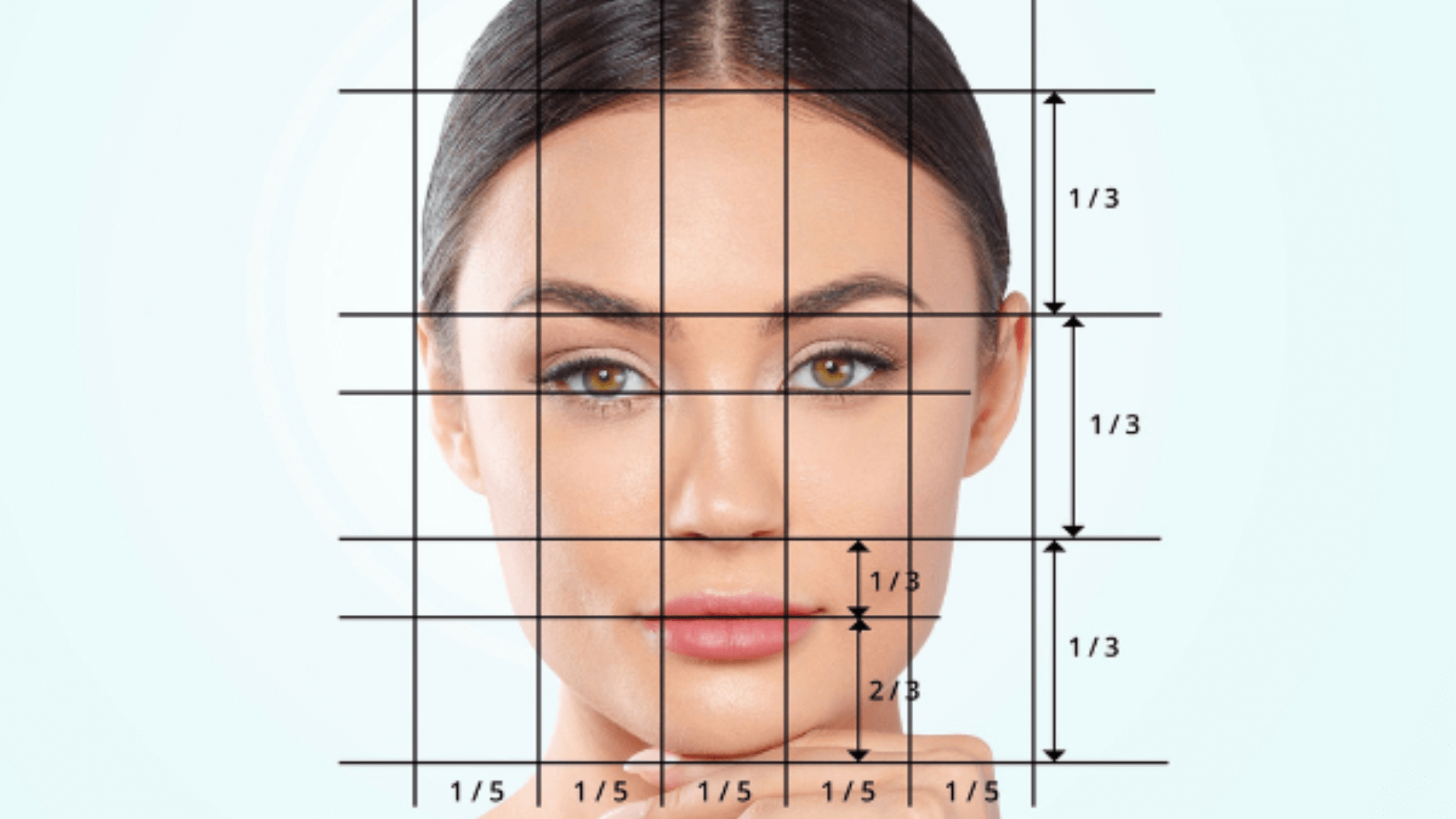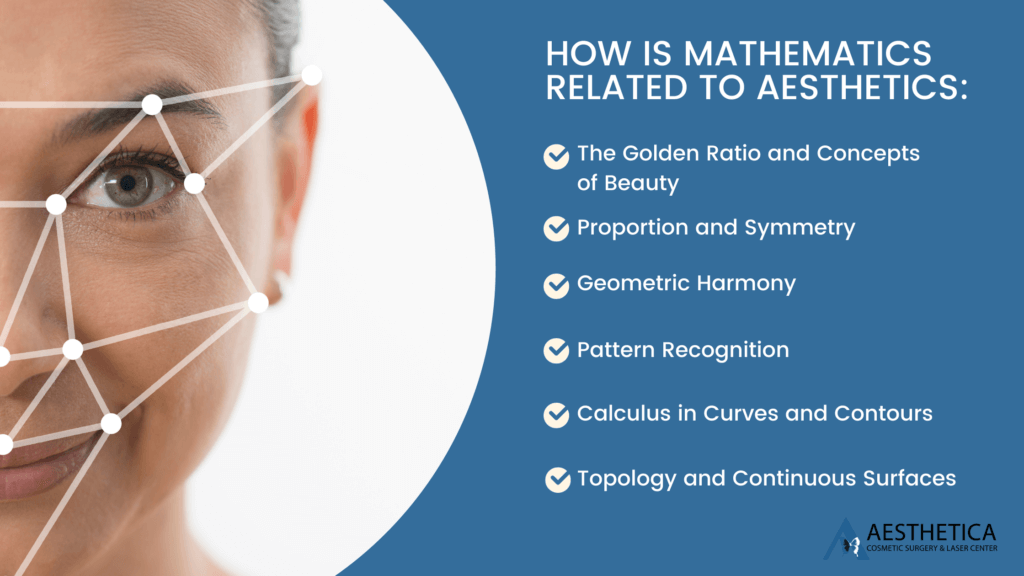
Aesthetica Editorial Team

At first glance, mathematics and aesthetic ideals might seem worlds apart. One is the domain of exactness and logic, while the other dwells in subjective perceptions and cultural nuances. However, upon closer inspection, these two fields merge in fascinating ways.
The same mathematical principles that brought Ancient Greece to majestic heights and guided Da Vinci’s brush in the ‘Mona Lisa’ are also at play in the meticulous and artful world of cosmetic enhancements.
From the proportions in facial symmetry to the geometric precision in body contours, math isn’t just about calculations and equations; it’s about the visual harmony that resonates with our deepest perceptions of beauty.
Let’s unscramble the numbers behind the beauty, revealing how a scalpel guided by mathematical precision carves your aesthetic ideals.
How Does Math Help Design?
In the realm of design, mathematics plays a crucial role in creating structures, products, and even graphics that are not only functional but also aesthetically pleasing.
Math provides a framework for understanding spatial relationships, proportions, and patterns, all critical in the design process. In architectural design, for instance, math creates buildings that are not only structurally sound but also pleasing to the eye, often employing ratios to achieve visual harmony.
Similarly, in the design of everyday objects, ergonomics relies heavily on mathematical principles to optimize functionality and appearance. Math is a foundational tool in design, enabling the creation of items and spaces that combine utility with beauty.
In the specific field of plastic surgery, math is crucial in designing surgical plans that aim for optimal outcomes. For instance, in reconstructive surgeries, mathematical calculations are essential for restoring symmetry and functionality to the affected areas.
In aesthetic surgery, such as body contouring or liposuction, math helps design procedures that enhance the body’s natural lines and curves, respecting the proportions that yield the most pleasing results.
Non-surgical treatments, like laser skin resurfacing, also benefit from mathematical precision in determining the right amount of treatment needed for desired aesthetic outcomes without compromising safety.
How is Mathematics Related to Aesthetics?

The fusion of mathematics and aesthetics is more profound than the recurring mention of the Golden Ratio.
It is a rich, intricate weave that forms the fabric of our perceived reality.
Mathematics provides a universal language of symmetry, pattern recognition, and proportionality, each thread contributing to the complex design of what humans consider beautiful.
The Golden Ratio and Concepts of Beauty
The intersection of math and beauty dates back to ancient civilizations, with the Golden Ratio as a prime example. Also known as Phi (φ), this mathematical proportion, approximately 1:1.618, pops up across natural elements and human creations alike and is renowned for its pleasing aesthetics.
Dr. Chang frequently uses this ratio as a guideline for creating harmony and balance, tapping into our innate sense of beauty subconsciously aligned with mathematical symmetry.
Surgeons use mathematical measurements to analyze facial structures, ensuring that enhancements like rhinoplasty or facelifts maintain or improve facial symmetry and proportion.
Similarly, non-surgical procedures, such as lip fillers, often refer to mathematical guidelines to achieve a balanced and proportionate lip shape that complements the overall facial structure.
Proportion and Symmetry
Beyond Phi, other proportions underpin the very nature of aesthetics.
The Rule of Thirds is often used in visual composition, particularly in photography.
It splits an image into thirds horizontally and vertically, suggesting that aligning the subject along these lines creates more tension, energy, and interest than simply centering the subject.
In plastic surgery, similar principles apply.
Surgeons often use mathematical symmetry as a guiding principle. However, perfect symmetry is rarely the goal, as it can appear unnatural.
Instead, calculated asymmetry, informed by mathematical understanding, achieves a more natural and attractive result.
This asymmetry aligns with the subtle irregularities found in nature, which are governed by Chaos Theory and fractals. This suggests that a degree of randomness is inherent to beauty.
Geometric Harmony
Euclidean geometry is fundamentally concerned with the properties and relations of points, lines, angles, and surfaces—initially set out in Euclid’s treatise “Elements.”
In facial aesthetics, Euclidean geometry provides a systematic approach for measuring and assessing the human face by considering it a geometric map.
The human face is divided into various geometric constructs. Euclidean geometry allows us to analyze these constructs using facial landmarks.
Facial landmarks are specific points on the face, such as the tip of the nose, the chin, or the peak of the forehead, which act as reference points.
By drawing lines and angles between these points, surgeons and aestheticians can define the geometric relationships that contribute to what is perceived as a harmonious face.
The Nasofrontal Angle
Various angles on the body can be measured and altered, such as the nasofrontal angle—the angle at which the forehead (frontal bone) meets the nose (nasal bone).
The ideal nasofrontal angle typically ranges between 120 and 130 degrees in men and 115 and 130 degrees in women, creating a sloped forehead-to-nose transition that is not too sharp.
The nasolabial angle assesses the aesthetic relation between the nose and the upper lip.
It is formed by the intersection of two lines—one that runs along the base of the nose between the nostril and the nasal tip and another that extends from the nasal tip to the area above the upper lip (the philtrum).
An aesthetically pleasing nasolabial angle typically ranges between 90 and 120 degrees, with the ideal angle being slightly obtuse to allow for a visually appealing projection of the nose.
Pattern Recognition
Humans are intrinsically tuned to recognize and find comfort in patterns.
This innate ability translates into an appreciation for patterns in aesthetics, seen in the repetitive motifs in design, the rhythm in music, and the natural arrangements in biology.
Mathematics describes these patterns with tools such as the Fibonacci sequence, where each number is the sum of the two preceding ones.
This sequence is found in nature in the spirals of shells or the arrangement of leaves. It has been used to analyze the proportions of the human body and face, striving to understand and replicate the natural sequence in artificial designs.

While the Fibonacci sequence is one of the most famous mathematical patterns related to aesthetics, it’s just one of the few patterns our brains are wired to perceive:
- Tessellations: These are patterns of shapes that fit perfectly together without gaps or overlaps, like the hexagons in a honeycomb.
In surgery, tessellations inform the optimal distribution of incisions or grafts, akin to a surgeon ’tiling’ with tissues to create a seamless and natural appearance.
- Wave Patterns: The sine waves and harmonic oscillations allow for replicating these natural rhythms in the contours of aesthetic enhancements, leading to results embodying a dynamic and fluid natural beauty.
- Fractals: Fractals—repeat patterns at different scales—are a mathematical concept found in natural phenomena such as coastlines, mountains, and clouds. Underlying mathematical principles govern these seemingly chaotic patterns, which are integral to our perception of the world’s natural beauty.
Calculus in Curves and Contours
Calculus, the mathematics of change and motion, is central to understanding the curves and contours of the body.
In aesthetic procedures, such as body sculpting, calculus helps predict changes in body contours over time and assists surgeons in planning procedures that anticipate and adapt to these changes.
Calculus is a branch of mathematics that deals with rates of change (differential calculus) and the accumulation of quantities (integral calculus).
Differential calculus focuses on the rate of change at any given point.
When examining a curve, such as the contour of a cheek or waistline, differential calculus helps surgeons understand how the slope of the curve changes at each point.
Integral calculus is about accumulation.
When adding volume, such as in fat transfer procedures, surgeons use integral calculus to determine how the overall shape of an area will change with the incremental addition of mass.
Modern aesthetic procedures are often aided by software like Vectra 3D Imaging, which can model the human body and simulate the effects of surgeries. Calculus is at the heart of these programs, predicting how body contours will look after the tissue is removed or added.
Topology and Continuous Surfaces
Topology, often called “rubber-sheet geometry,” explores properties that remain unchanged even under transformations such as stretching or bending.
In reconstructive surgery, topology principles ensure that skin and tissue modifications maintain their fundamental properties, enabling surgeons to predict how adjustments will look and function post-procedure.
Discover Perfect Balance in Your Aesthetic Journey!

Meet us at 19500 Sandridge Way, Suite 350, Leesburg, VA 20176, or call us at (703) 574-4342 for a complimentary consultation with Board-Certified Plastic Surgeon Dr. Phillip Chang before moving forward with your procedure. If everything matches up, our team will help you navigate the entire process from beginning to end. Also, remember to check out our blog and social media for more information on cosmetic surgery trends!
Let Us Help You!
Our office can provide you with helpful information, schedule a free consultation, and walk you through the many services and procedures we provide.
Contact Dr. Chang's Office:
More Articles For You

The Latest Techniques in Double Chin Removal in Leesburg, VA
In the charming town of Leesburg, VA, where looking good and feeling great are top

The Art of Refining the Side Profile of a Woman through Plastic Surgery
In the realm of cosmetic enhancements, the side profile of a woman holds a pivotal

Enhance Now, Pay Later: Plastic Surgery Payment Plans in Leesburg, VA
In the picturesque town of Leesburg, VA, pursuing beauty and self-improvement is a journey many

Areola Reduction for Men in Loudoun County
In the heart of Loudoun County, where the beauty of nature meets bustling urban life,
